Spy fiction is a genre of literature involving espionage as an important context or plot device. It emerged in the early twentieth century, inspired by rivalries and intrigues between the major powers, and the establishment of modern intelligence agencies. It was given new impetus by the development of fascism and communism in the lead-up to World War II, continued to develop during the Cold War, and received a fresh impetus from the emergence of rogue states, international criminal organizations, global terrorist networks, maritime piracy and technological sabotage and espionage as potent threats to Western societies. As a genre, spy fiction is thematically related to the novel of adventure, the thriller and the politico-military thriller.
Genre fiction, also known as popular fiction, is a term used in the book-trade for fictional works written with the intent of fitting into a specific literary genre, in order to appeal to readers and fans already familiar with that genre.
Literary fiction is a label that, in the book trade, refers to market novels that do not fit neatly into an established genre ; or, otherwise, refers to novels that are character-driven rather than plot-driven, examine the human condition, use language in an experimental or poetic fashion, or are simply considered "serious" art.
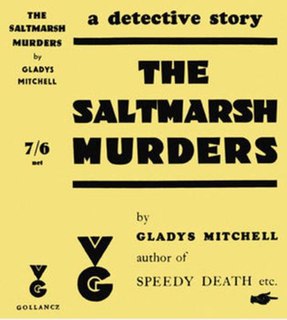
The Saltmarsh Murders is a 1932 mystery detective novel by the British writer Gladys Mitchell. It is the fourth in her long-running series featuring the psychoanalyst and amateur detective Mrs Bradley. It has been highly acclaimed as a part of the Golden Age of Detective Fiction.

The Curse of Doone is a 1928 mystery thriller novel by the British writer Sydney Horler. It also has element of horror about it. It was published in America in 1930 by The Mystery League.
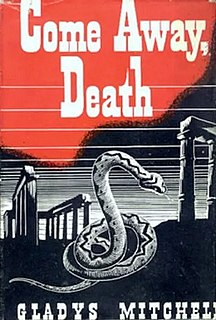
Come Away, Death is a 1937 mystery detective novel by the British writer Gladys Mitchell. It is the eight in her long-running series featuring the psychoanalyst and amateur detective Mrs Bradley. Although the plot revolves around Greek Mythology, the title is taken from a line from Shakespeare's Twelfth Night. It was followed by a loose sequel Lament for Leto in 1971.

I'll Say She Does is a 1945 thriller novel by the British writer Peter Cheyney. It is the tenth in his series of novels featuring the FBI agent Lemmy Caution. Later editions of the book are generally titled I'll Say She Does!
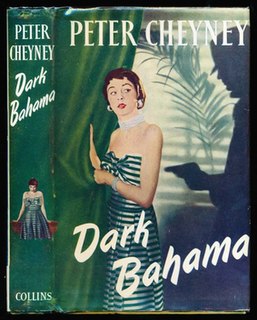
Dark Bahama is a 1950 thriller novel by the British writer Peter Cheyney. It was the second in a trilogy featuring the private detective Johnny Vallon, a hard-drinking former army officer. The story also features Quale, the head of British intelligence who appears on several other novels by Cheyney. Much of the action takes place in a fictional island in the Bahamas and nearby Miami in Florida.

Ladies Won't Wait is a 1951 spy thriller novel by the British writer Peter Cheyney. It is a sequel to the 1945 novel Sinister Errand and portrays the continued adventures of Michael Kells, a half-American, half-British secret agent. It was published in the United States under the alternative title Cocktails and the Killer.
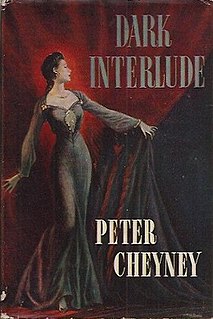
Dark Interlude is a 1947 spy thriller novel by the British writer Peter Cheyney. It features a British secret agent Shaun Aloysius O'Mara and his superior Quale, a recurring figure in Cheyney's novels.

Dark Duet is a 1942 spy thriller novel by the British writer Peter Cheyney. Cheyney had become known for his hardboiled crime thrillers featuring Lemmy Caution and Slim Callaghan, but this novel was his first fully-fledged espionage novel. The novel is set in wartime London, Lisbon and Ireland. It was published in the United States with the alternative title The Counterspy Murders.
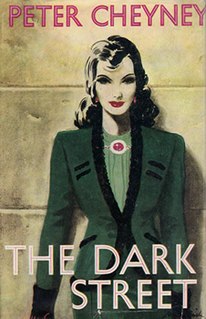
The Dark Street is a 1944 thriller novel by the British writer Peter Cheyney. It was published in the United States by Dodd, Mead with the alternative title of The Dark Street Murders. It follows on from both the 1942 novel Dark Duet and the 1943 novel The Stars Are Dark and features his recurring head of British counter intelligence Quale as well as the spy Shaun O'Mara. It begins in wartime occupied Paris before moving to London.

The Stars Are Dark is a 1943 spy thriller novel by the British writer Peter Cheyney. It was published in America with the alternative title The London Spy Murders. It follows on from the 1942 novel Dark Duet focusing on British counter intelligence operations during the Second World War, and introduces the character of Quale a senior British intelligence officer would appear in several novels.
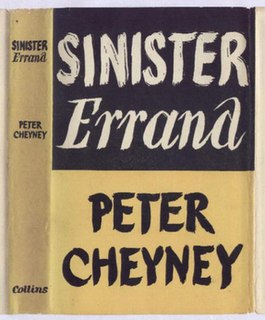
Sinister Errand is a 1945 spy thriller novel by the British writer Peter Cheyney. Cheyney known for his creations Lemmy Caution and Slim Callaghan, introduced a new character the half-American secret agent Michael Kells. It was followed by a sequel Ladies Won't Wait in 1951.

Up the Ladder of Gold is a 1931 thriller novel by the British writer E. Phillips Oppenheim. He dedicated the work to the comedy writer P.G. Wodehouse. It represented the apex of Oppenheim's portrayal of the great man as a dynamic force.

A Lost Leader is a 1906 politically-themed novel by British writer E. Phillips Oppenheim. Later better known for his thrillers, it was one of several novels Oppenheim wrote at the time centred on "social political life". In it, a potential Liberal Party politician, Lawrence Mannering, is lured back from his country estate to London to revive the party's fortunes.

The Colossus of Arcadia is a 1938 spy thriller novel by the British writer E. Phillips Oppenheim. Oppenheim enjoyed great popularity in the interwar era for his series of thrillers, often concerning international intrigue. Set in Monaco, a frequent location in the author's novels, it uses passengers arriving and then departing on the Blue Train for its opening and closing chapters.
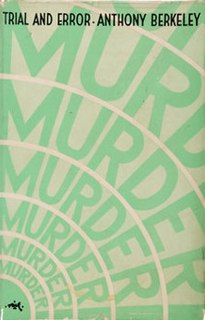
Trial and Error is a 1937 mystery detective novel by the British writer Anthony Berkeley. It was a loose sequel to the 1929 novel The Piccadilly Murder, featuring two of the characters from the earlier work the unprepossessing but shrewd Ambrose Chitterwick and Chief Inspector Moresby of Scotland Yard. Berkeley was a prominent author of the Golden Age of Detective Fiction, known for his inverted detective stories.

Not to Be Taken is a 1938 mystery detective novel by the British writer Anthony Berkeley. It was one of several stand-alone novels he wrote alongside his series featuring the private detective Roger Sheringham. It was written when the Golden Age of Detective Fiction was at its height. It was published in the United States with the alternative title A Puzzle in Poison.

Mr. Grex of Monte Carlo is a 1915 spy novel by the British writer E. Phillips Oppenheim. The action takes place in Monaco, a favourite setting in the author's novels. Oppenheim was a pioneer of the modern spy genre, often giving his works a glamorous international setting. Although published in 1915, it was likely to have been written in 1914.

















